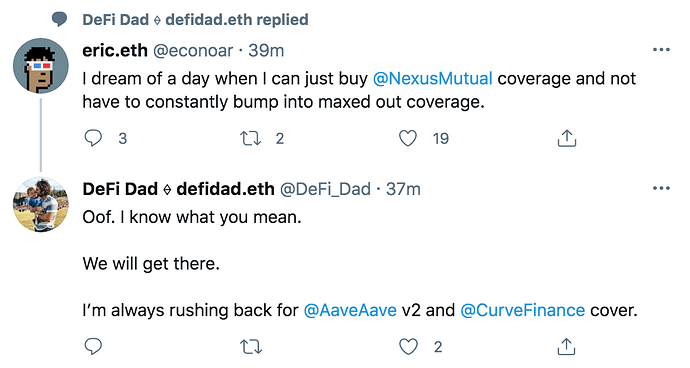Currently, seven projects are unavailable for cover. The active cover in ETH at the time of writing (May 22nd) is 283,211 and the seven projects which are maxed out contribute 85,066 of that, or 30%.
*Uniswap v3 has some very small capacity right now, but didn’t when I wrote this post
| PROJECT | ETH COVER | REASON | CAPACITY FACTOR |
|---|---|---|---|
| Curve All Pools (incl staking) | 34179 | MCR CAPPED | 4 |
| Aave V2 | 16317 | Requires more staking | 1 |
| SushiSwap V1 | 13227 | Requires more staking | 1 |
| TrueFi | 8834 | Requires more staking | 1 |
| Alpha Homora V1 | 6428 | Requires more staking | 1 |
| Liquity | 4752 | Requires more staking | 1 |
| Uniswap V3 | 1326 | Requires more staking | 1 |
It’s fair to assume that any additional cover capacity that is opened up will be utilized quickly, because many of these projects are growing their own userbase and have been capped or limited on Nexus Mutual for some time.
For Curve, the only option would be to increase MCR, or for us to be more liberal with the 20% cap on any single risk (not a good idea).
However, for the other projects they all have a capacity factor of 1, I believe. I’m guessing for Uniswap v3 as I couldn’t find it listed anywhere. For comparison, Uniswap v2 has a capacity factor of 4.
Doubling the capacity from 1 to 2 for the remaining projects would still be relatively low risk. Governance proposal 118 pushed the factor from 2 to 4 for similar projects. That proposal was approved in January, so it could be done again for these other projects.
We do anticipate that all capacity factors will be reduced towards 1 for staking 3.0. But, if this is still a way away, it seems smart to increase these factors and take advantage.
Going to 2x would open up 50,886 ETH capacity. If that capacity was to be fully filled, it would represent a 17.97% increase in cover for the mutual. That’s obviously a very sizable increase in premiums, and would allow us to grow the capital pool quicker. But offering more cover also helps us to spread the good word of the mutual! Rather than having customers come to our website, only to leave frustrated day after day because capacity is not available, they get to take advantage of this new capacity. Win, win.
985,462 is being staked right now. That means only 14.25% of the potential 6,916,805 NXM is being staked.
Another way to look at it is that 10,029,355 NXM is currently staked against cover, since each NXM can be staked with 15x leverage. That’s 9.67% of the potential maximum that could be staked at any given time (with the current leverage ratios). Since this is less than the 14.25%, we know that many members are not using the full 15x leverage that is available.
So, I don’t think increasing the leverage is the way to fix this issue. Any increased leverage is more likely to be used against less popular projects, as inherently the most popular projects are those which are getting the most staked already, obviously. Plus, leverage is less likely to push those already not staking, to start. At least, compared to some other options we have.
Another option would be to incentivize staking on those projects with no capacity. This will eventually happen with pricing that scales based on demand. Again, what can we do NOW to try and improve it? Adding some additional incentive, funded by the community fund (?), to each of the above projects (excluding Curve) seems to be a good idea until Staking 3.0. Any additional staking opens up capacity and earns the mutual more premiums.
Thoughts?
